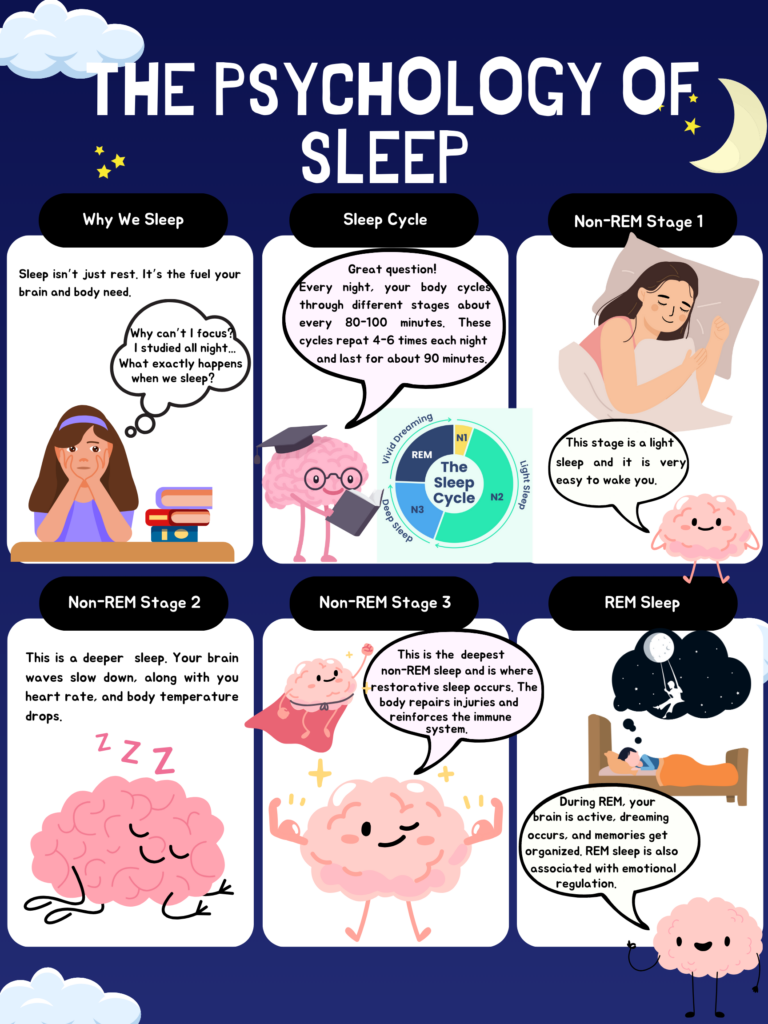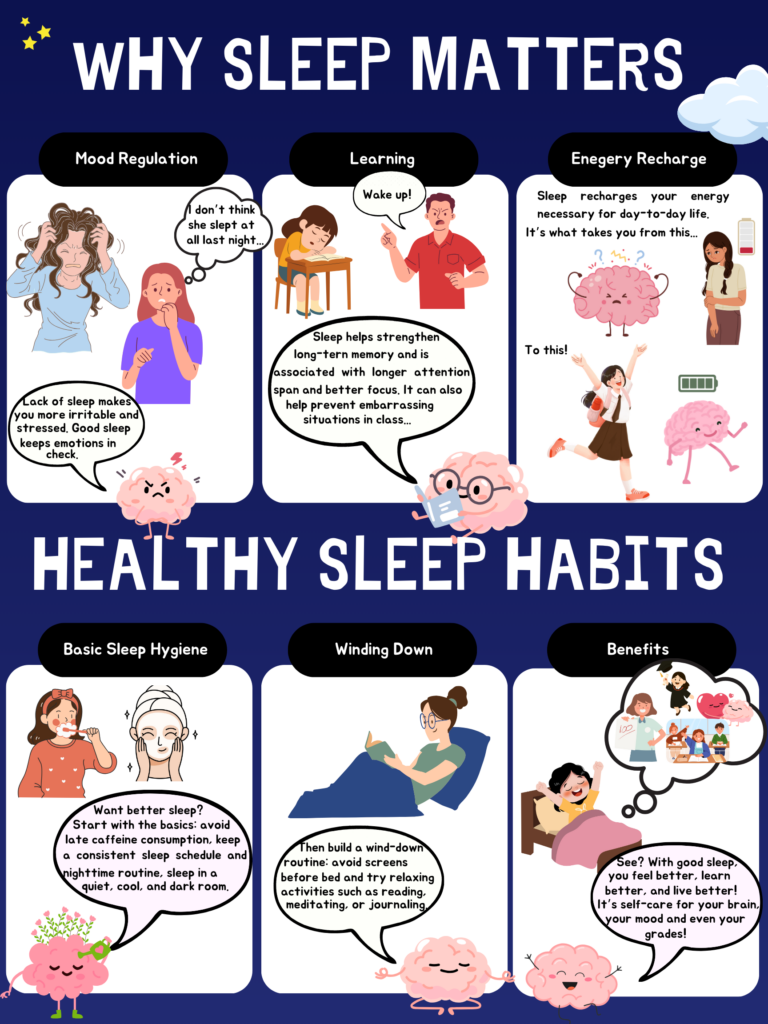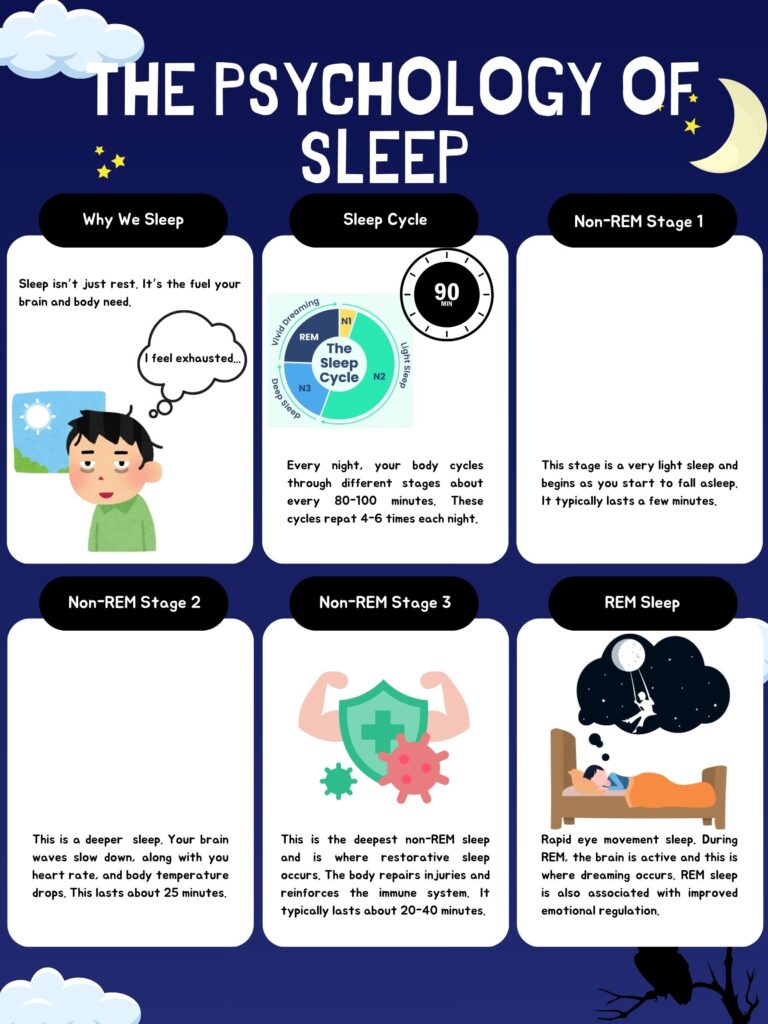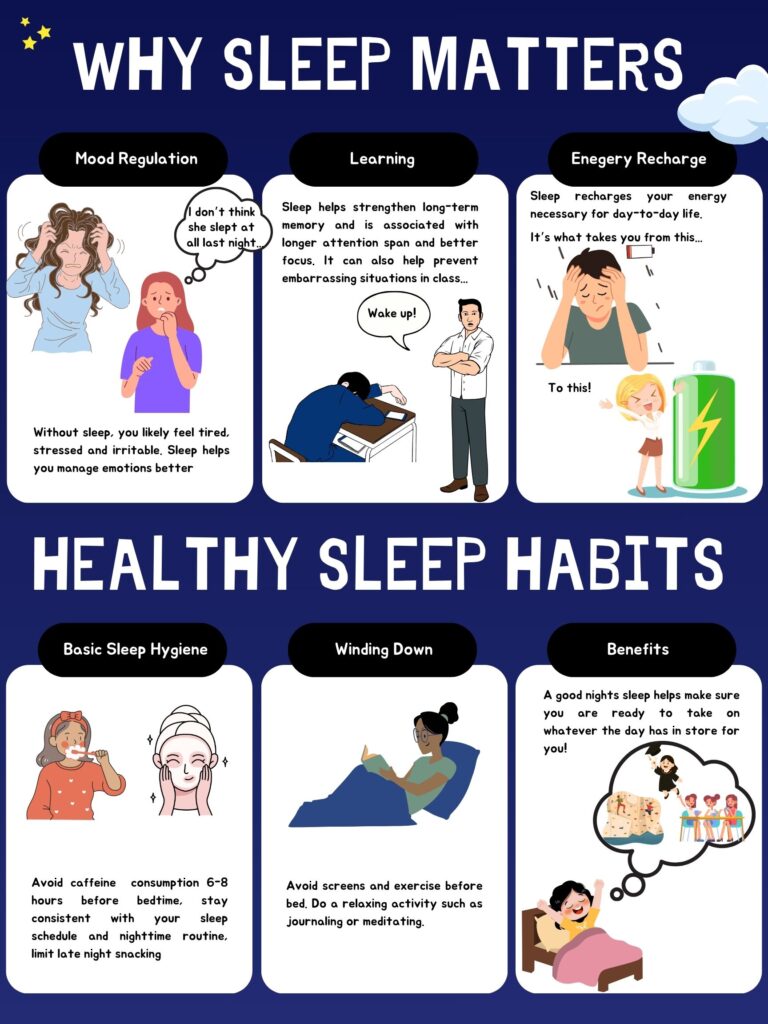Challenge A: Comic – The Psychology of Sleep
Updated: September 25, 2025
Author: Emma Lee
I am creating this educational comic because as a psychology student, I understand the importance of a good night’s sleep and how it improves both physical and mental well-being. My goal for this project is to educate other students and to hopefully convince them that sleep is the healthier alternative to staying up all night to finish assignments or cramming for tests.


Describe the Challenge
Many post-secondary students disregard the importance of proper sleep and are unable to develop healthy sleeping habits.
Context and Audience
My target audience are post-secondary students as the details outlined in the comic pertain mostly to them (e.g., stress due to school, attending classes, etc), however there are many sections of the content that will be relevant to students of all ages as well as the general population as sleep is important to all. Post-secondary students may be more likely than other age groups to skip sleep due to staying up to work on school, studying, staying out late with friends, partying, or working overnight while attending school during the day.
The basic needs of post-secondary students would likely be to get good grades in classes while also spending time with friends, maintaining relationships, and making money to support themselves. This will vary depending on any extracurriculars or hobbies the student is interested in. In order to accomplish this, students need the energy and mental capacity which comes from getting restful sleep. However, sleep is often disregarded as some may feel it is a waste of time because they cannot be productive while they sleep. This is false. Although individuals may not be getting work done while sleeping, they are preparing themselves to be more productive, focused and attentive when they wake up, which is something students may take for granted.
As I mentioned earlier, a lot of the content in the comic applies to students of all ages, however, depending on their age, they may need more or less sleep than a post-secondary student would. Younger children also are much more reliant on their parents and guardians to walk them through their bedtime routine and provide suitable entertainment before bed such as books, therefore, this information is less relevant for them but can still be important knowledge for the future. They may not have unlimited use of electronic devices as well, eliminating another distraction that could prevent them from having a good night’s sleep.
Older and middle-aged adults can also use these strategies to improve their sleep. Instead of classes and tests/assignments, they likely have work and deadlines to meet instead. The same sleep habits apply here. It is a better choice for their well-being for them to rest and sleep than to stay up all night to work. Even though that might not be possible in some situations, it is still important to try your best and prioritize your health.
POV Statement
A student who is tired, unable to focus in class, and is struggling to balance activities from their day-to-day life needs to learn how sleep impacts their brain and body so they can set a healthy sleep schedule to improve their memory, concentration and their overall well-being.
Learning Objective
By the end of this educational comic, students will be able to:
– Explain the impact of sleep on physical and mental health by identifying its role in emotion regulation, stress reduction, and supporting overall well-being.
– Describe how insufficient sleep affects academic performance by examining its effects on memory retention, ability to focus, and overall achievement.
– Apply healthy sleep strategies to improve daily functioning by practicing effective sleep hygiene routines and wind-down techniques.
Ideation
My most promising prototype starts with a student who is exhausted and stressed. The sleep cycle is explained along with the benefits of sleep and helpful tips on improving your sleep.
Storyboard/Script
- Why we sleep
- Sleep cycle: Lasts about 80-100 minutes, then repeats. People typically go through 4-6 cycles each night
- Non-REM Stage 1 – light sleep – this stage starts right as you fall asleep
- Non-REM Stage 2 – deeper sleep – brain waves slow down
- Non REM – Stage 3 – deepest non-rem + restorative sleep – body repairs injures and reinforces immune system
- REM Sleep (rapid eye movement) – brain is active, where dreaming happens
- Why does sleep matter – Mood regulation – irritable, stressed and tired, not enjoyable to be around, sleep helps you manage emotions better
- Sleep and learning – lack of focus, bad memory – sleep strengthens long-term memory, better attention span
- Energy recharge – sleep recharges your energy which is necessary for sports, education and day-to-day life
- Healthy sleep habits: Hygiene basics – no caffeine, regular bedtime, dark room,
- Wind down routine – read a book, no screens, do something relaxing
- Benefits of good sleep
Principles Applied
The contiguity principle was used in my comic, keeping the text and its associated image(s) close together so the audience knows what the text is referring to. The personalization principle was also demonstrated and can be seen by the use of contractions and a more casual, conversational tone. The signaling principle was also seen by the use of headings and subheadings in the comic, along with the coherence principle which helped me get rid of irrelevant information.
Prototype
I decided to use Canva to create my comic and am still in the process of finding images and adding speech/thought bubbles. All the images are from Canva besides the sleep cycle diagram which is from Sleep Foundation.


Peer Feedback
The feedback I received was to add clear visuals to the sleep cycle section to help the reader understand easier. Having a more consistent tone throughout the comic was another comment that was made as there was a mixture of more scientific information and casual text and images. Positive feedback I received was that the short phrases and texts were clear, easy to understand, and relatable to the audience.
Other suggestions I received were to strengthen the tie between healthy sleep and students as that is my main target audience and to expand the benefits of sleep section to connect it to academic performance and mental health. A better balance between the images and text was also suggested as due to my topic choice some panels are more scientific and text heavy.
Reflect and Refine
The program I used to create the comic, Canva, worked very well. I had originally planned on using Comic Life 3 but ultimately found it too time-consuming learning how to use a brand new program. Since I have used Canva many times in the past, it was very simple and easy to use.
I took the suggestions to alter the tone of the comic so it was more consistent, making a more casual tone overall. I also added clear visuals in the sleep cycle sections. I made sure there were more connections to student life in the comic, mentioning staying up all night to study, falling asleep in class, and improved academic performance when you get a good night’s sleep. I removed some text so the audience could focus on the images more, however, I wasn’t able to remove a lot as I still wanted to ensure they understood the sleep cycle and the points I was trying to make.
One of the main issues I had was that my prototype read more like an infographic rather than a comic due to the lack of a clear story. I addressed this by adding more of a plot into the comic and having a “brain character” explain the importance of sleep to the student who is questioning sleep at the start, and at the end there is a positive outcome as she learns why good sleep is necessary. Another issue, though not as major, was due to using the pre-made graphics and images on Canva. This led to a different image of a girl in each panel and though I tried to make her look as similar as I could to the first panel, you can clearly tell that it is not the same girl. However, I thought that this could allude to the idea that sleep is important for everybody and we all should be taking these steps to improve our sleeping habits and overall well-being.
Strengths of this type of multimedia for learning are the use of a combination of both text and images. This works because of Allan Paivio’s dual-coding theory, since we have two different channels where we can process language and text at the same time (Loveless, 2023). Educational comics are also more engaging than other more common ways of learning that students receive such as presentations and lectures. They can help break down challenging topics in a more interesting and entertaining way. Step-by-step panels use the segmenting principle (Granchelli, 2025), chunking information and making it more manageable and organized for the audience.
Limitations of this type of multimedia for learning could be the lack of depth and/or details. Educational comics may not be able to present all the necessary information and could summarize or oversimply complex topics. If the topic is brand new to the audience, an educational comic might be a good idea to introduce them to the content, followed by a more detailed way of presenting information. Depending on the learning style of the audience, an educational comic may work well if they are more visual learners, however, some may prefer traditional lectures or readings.
References
Canva. (2025). Canva. https://www.canva.com/
Granchelli, Adrian. (2025). Theories of multimedia learning EDCI 337. Educational technology Uvic. https://edtechuvic.ca/edci337/2025/09/05/theories-of-multimedia-learning/
Loveless, Becton. (2023). Dual coding theory: The complete guide for teachers. Education Corner. https://www.educationcorner.com/dual-coding-theory/
Sleep cycle. (2025). Sleep Foundation. https://www.sleepfoundation.org/stages-of-sleep